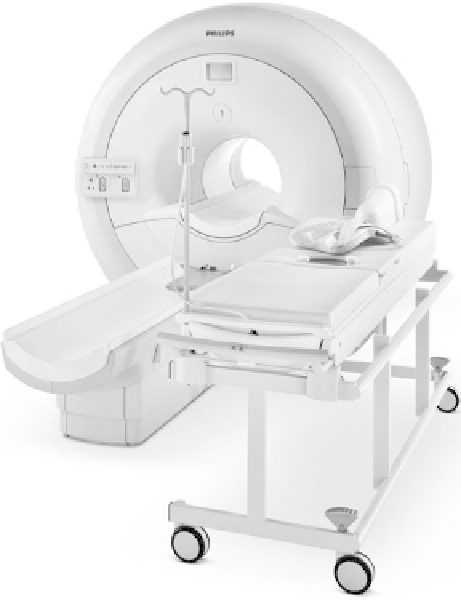Biomedical Engineering Reference
In-Depth Information
of preclinical and clinical results, the guideline for HIFU dose
delivery was established for the Haifu system. There are expert
databases of the dosimetry and dose delivery guidelines in the
central operator console, which were collected from a large vol-
ume of therapeutic data from patients treated. Moreover, ultra-
sound dose must also be controlled using ultrasound imaging
as explained previously. The guidelines of dose delivery with the
Haifu systems are outlined here:
the depth of the targeted tumor (from the skin to the tumor), the
structure and functional state of the biological tissues, and the
focus scanning mode.
10.4 philips Sonavelle Mr-HIFU System
The systems presented previously are clinical in the sense that
they have received FDA clearance in the United States or the
CE mark in Europe for specific clinical indications in humans.
In this section we briefly introduce a new system developed by
Philips, which is expected to enter the clinical market in the near
future.
The Sonalleve MR-HIFU system (Philips Healthcare, Vantaa,
Finland) was designed with the main objective of improving
treatment efficiency (Figure 10.14). This objective is achieved
by a volumetric ablation technique reminiscent of focus scan-
ning techniques used earlier in non-ablative scanned focused
ultrasound hyperthermia treatments (Moros et al. 1988).
Volumetric ablation is accomplished by scanning the focus in
concentric circles rapidly and outwardly, and repeating the pat-
tern until the target is ablated. This approach produces homo-
geneously ablated volumes in relative short times (Köhler et al.
2009). The same scanning technique is also being investigated
for enhanced drug delivery via hyperthermia. Nominal target
volumes (or cells) available are 4, 8, 12, 14, and 16 mm in diam-
eter. The nominal length of the cylindrical volume varies with
10.3.5.1 HIFU Biological Focal region (BFr)
One HIFU exposure or sonication of sufficient power produces
a single spot of coagulation necrosis in soft tissue. In addition
to heat, nonlinear effects such as cavitation are involved in the
necrosis formation. Fry (1993) considered that the practicality
of focused ultrasound depends on the tissue properties between
the ultrasonic source and the focal region, and the energy accu-
mulation in the focal region. Therefore, the treatment of a given
target requires a special correction method depending on the
various organs and tissues involved. The variation of the coagu-
lation necrosis zone in targeted tissues must be determined as
a requirement of clinical treatment procedures. In this con-
text, Wang et al. (2003) termed the single coagulation necrosis
induced by a single HIFU exposure as a HIFU Biological Focal
Region (BFR), which is related to the Acoustic Focal Region
(AFR) produced in a water tank. Detailed studies show that BFR
is based on AFR and is a function of the acoustic intensity, expo-
sure time, treatment depth (distance from the focus to the skin
surface), tissue structure, and functional status. Mathematically,
BRF can therefore be expressed as follows:
BFR(AFR, ,, ,, )
s
=
f
I tDTT
f
where,
I
is the acoustic intensity,
t
is the exposure time,
D
is the
depth of treatment,
T
s
is the structure of the biological tissue,
and
T
f
is the functional state of the tissue.
10.3.5.2 the Energy Efficiency Factor
(Energy Effect Factor, EEF)
The BFR reveals a general principle that there are multiple fac-
tors influencing the formation of coagulation necrosis. The aim
of three-dimensional conformal treatment planning is to cover
the volume of an entire tumor with coagulation necrosis. The
concept of the energy efficiency factor, or EEF, is put forward for
the determination of the ultrasound energy needed to be deliv-
ered to a target volume to cause coagulation necrosis. In other
words, the dose-effect relationship is quantified by the EEF as
follows,
=
η
Pt
EEF
(J/mm3)
V
where η is the energy conversion coefficient of the HIFU trans-
ducer (η ∼ 0.7),
P
is the acoustic power,
t
is the total time of treat-
ment, and
V
is the volume of the target. Results show that using
the same transducer, EEF is affected by several factors including
FIGURE 10.14
The Philips Sonavelle MR-HIFU system. (Courtesy of
Philips Healthcare.)


